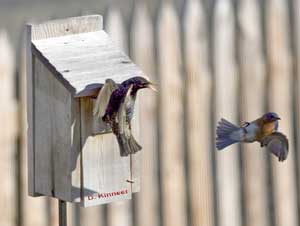These days, the news is filled with the negative impact people are having on the planet, from pollution to extinction. But interfering with the ecosystem is nothing new for humans.
In 1890 and 1891, about 60-100 European Starlings (Sturnus vulgaris) were released into Central Park, NY by The Acclimatization Society of North America. The misguided goal of this now defunct organization was to introduce all the birds mentioned in Shakespeare's works. The entire North American population of Starlings, numbering more than 200,000,000, is believed to have descended from these birds. By the late 1940s, they had spread to nearly all of the U.S. states and Canadian provinces. Today they are the most numerous bird in the U.S.
Starlings share the characteristics of other invasive animals or plants: they reproduce rapidly, are adaptable and aggressively compete for nesting sites with native species like bluebirds. A starling can build a nest in 1-3 days. Both sexes incubate the eggs. These bold scavengers are no friend of the farmer. They will eat just about anything, with a special fondness for fruits like strawberries, blueberries and grapes. In an hour, a flock that can number 100,000 birds can wipe out wild berries that could have sustained native birds for the entire winter. These avian invaders also consume large quantities of livestock feed, seeds, insects, invertebrates, and garbage.
 |
A Starling attempts to take over a Bluebird nestbox. Photo by Dave Kinneer. |
Starlings will engage in screaming, kicking and stabbing food fights with each other. They also compete fiercely with native species like Wood Ducks or Flickers for natural or woodpecker cavities for nesting. Fortunately for bluebirds and other small cavity nesters, Starlings are too big to enter a birdhouse that has a 1.5” entrance hole. However, if the hole is enlarged by a creature such as a squirrel, Starlings can evict any tenants. They also like to nest in holes in buildings like barns or attics. They may roost communally in flocks containing as many as a million individuals.
If you see a swarm of black birds moving through the air in a fluid dance like a school of fish, they are probably Starlings (watch video). They are found where ever there is food, nest sites and water - typically around cities and towns, near bird and suet feeders, and in agricultural areas. They do not frequent large expanses of woods. Starlings are about the size of a chunky Robin. They sport speckled, glossy black plumage with an iridescent green or purple sheen, and a long pointy beak. Unlike Grackles, they have a short, squared tail. Both males and females can mimic human speech. Starlings can also imitate the song of other birds like Meadowlarks and Northern Bobwhites.
Out of the top ten bird species reported in Connecticut during the 2006 Great Backyard Bird Count, two were intentionally introduced: the European Starling (#4) and the (English) House Sparrow (#6). Because they are both non-native invasive species, they are not protected by The Migratory Bird Treaty Act. This means that federal law allows humane and safe destruction of adults, nests, eggs, and young.
By the way, congratulations to those in our area who participated in this years’ Great Backyard Bird count during President’s day weekend. So far in 2007, 59 checklists have been submitted for the towns covered by The Villager newspapers. This is more than triple the number sent in 2007. Woodstock is currently in the lead, with 29 species counted on 20 checklists. Data entry closed on February 28. To see a free slide show about Starlings and other cavity nesters, come to the Babcock Public Library on 25 Pompey Hollow Rd. in Ashford on March 16th at 7:00 p.m. |

